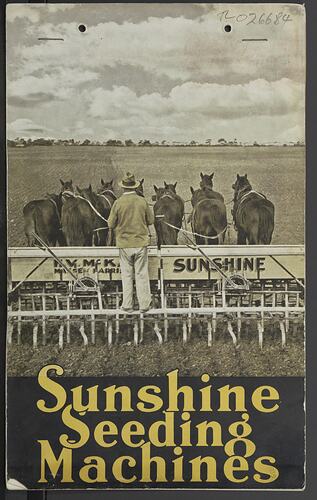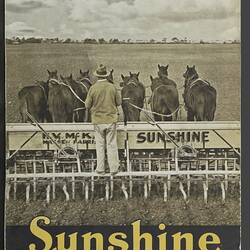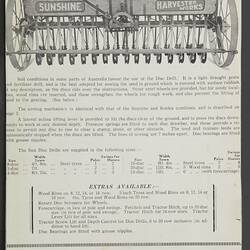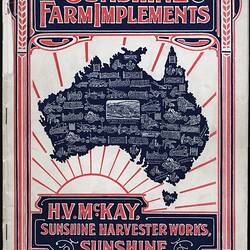Summary
Product catalogue for the Suntyne and Sunlea Cultivators includes detailed diagrams of the products and text explaining their key features as well as specifications.
The catalogue places the product in an environmental context stating that the correct sowing of seed is of vital importance in Australia "where the rainfall is intermittent and uncertain." The catalogue claims that the product will lead to a successful harvest even "though rains are below the average, and fall at inopportune periods".
The photographs featured in the catalogue provide an interesting insight into changes in farm technology in the pre-World War II period. The front cover features a farmer operating a cultivator that its being drawn by a team of twelve horses. Within the catalogue there are a number of images of a farmers using both tractors and horses to draw cultivators. This was period where the use of horse power was being phased out, as more and more farmers were using tractor power for their work. This catalogue captures this period of change, showing the Company still marketing to farmers continuing to use horse power as well as farmers adopting new technology.
Some of the images in the catalogue have captions and show farming in the Wimmera area and Horsham. An image of two farmers Messrs O. and G. Gerlach is also included.
There are a number of hand-written notations in ink in the catalogue that may relate to the make and number of parts.
Part of a collection of photographs, negatives, moving film, artefacts, documents and trade literature belonging to the H. V. McKay Sunshine Collection. The McKay collection is regarded as one of the most significant industrial heritage collections in Australia. The collection relates to the agricultural manufacturing firm, the Sunshine Harvester Works. The Australian operations of this company were originally founded by Hugh V. McKay in the 1890s in Ballarat. Between 1906 and 1907, McKay moved production to Sunshine where the firm became one of the largest industrial businesses in Australia. Change in ownership is a recurring theme in the company's history. In 1930, it merged with Massey-Harris to become H.V McKay Massey Harris. In the mid-1950s, the company was absorbed by Canadian agricultural firm Massey-Ferguson. Production in Sunshine ceased in the mid-1980s, following almost 100 years of manufacturing agricultural equipment.
Title
'SUNSHINE SEEDING MACHINES' ... L308, 7441, DBm, 339.'
More Information
-
Collection Names
H.V. McKay Sunshine Collection, Old McKay Archive (Transfer No.2)
-
Collecting Areas
-
Acquisition Information
Donation & Transfer from Old McKay Archives, Science & Technology Collection, Museum Victoria, H.V. McKay Pty Ltd, Sunshine Harvester Works, H.V. McKay Massey Harris Pty Ltd, Before 1987
-
Manufacturer/Distributor
H.V. McKay Massey Harris Pty Ltd, Sunshine Harvester Works, Sunshine, Melbourne, Victoria, Australia
-
Publication Date
1939/03
-
Place & Date Depicted
-
Place & Date Depicted
-
Printer
-
Brand Names
"SUNSHINE" (Seed & Fertilizer Drills) , "SUNTYNE" (Seed & Fertilizer Drills) , "SUNLEA" (Seed & Fertilizer Drills) , "SUN" (Seed & Fertilizer Drills)
-
Number of Pages
18
-
Page Size Format
150 mm x 250 mm
-
Primary Subject
-
Illustration Types
Black & White; Line Drawings; Photographs
-
Printing Types
Limited Colour
-
Publication Types
-
Classification
Agriculture & rural life, Crop management - seeding & fertilising, Seed & fertiliser drills
-
Category
-
Discipline
-
Type of item
-
Keywords
Droughts, Environmental Issues, Farming Methods, Horses, Rainfall, Seed & Fertilizer Drills, Seed Drills, Technological Changes, Technology & Innovation, Tractors, Agriculture, Agricultural Equipment, Innovation & Design






